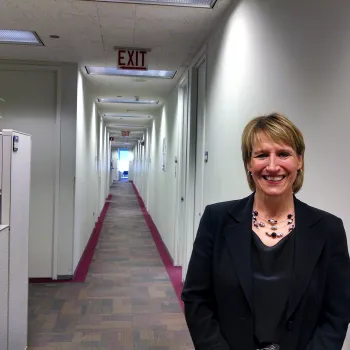In the federal probation office in Chicago, there’s one certain sign of a busy workplace: empty hallways and unoccupied desks.
Aided by rapidly changing mobile technology, probation officers increasingly work in the community, visiting homes and workplaces of convicted offenders who are reentering society under supervision. Reporting in via cellphones and tablets, the officers can spend long hours, even days, outside the office.
This mobility protects the public, through closer supervision of potentially dangerous offenders. But for federal courts, it also represents an intriguing opportunity to shrink rent costs. The Chicago probation office is the first pilot project of an initiative to reimagine, and downsize, the traditional office workplace.
The program is called the Integrated Workplace Initiative (IWI), which employs technology to literally break down the walls in court and probation offices. Instead, IWI calls for a visually open, space-efficient network, where employees shift among workspaces and are not tethered to assigned desks.
The Chicago project shows IWI’s dramatic potential for cutting space, and rent costs. When the probation officers relocate in 2015, they will move from 53,000 feet of leased commercial space to about 20,000 square feet in the John C. Kluczynski Federal Building, located downtown near the Everett M. Dirksen U.S. Courthouse. That represents a space reduction of 55 percent, and projected annual rent savings of more than $1.4 million.
Such savings are increasingly essential for the Judiciary, which doesn’t own property and must pay $1 billion in annual rent to the General Services Administration (GSA) for courthouses and other space. Containing rent costs has been identified as the federal courts’ single greatest cost-saving initiative.
“Our rent bill is huge, and unfortunately some of this rent is paid on empty or inefficient space,” said Judge D. Brooks Smith, chair of the Space and Facilities Committee of the Judicial Conference of the United States. “Each dollar that we save in rent can be used to help retain court staff. Given the staffing reductions we have suffered in the past few years, this has to be a priority.”
Jeanne Walsh, Chief U.S. Probation Officer in the Northern District of Illinois, said her predecessor asked for guidance on whether to renew the Chicago office’s expiring lease. With staffing down and officers increasingly in the community, the office seemed oversized.
The Judiciary began working in partnership with the GSA, whose Total Workplace initiative is advancing similar projects in Executive Branch agencies. GSA is funding the planning and design phases in Chicago, as well as a special IT study to provide strategies supporting a mobile workplace.

"Our rent bill is huge, and unfortunately some of this rent is paid on empty or inefficient space," says Judge D. Brooks Smith, chair of the Judicial Conference's Committee on Space and Facilities.
Project designers have met extensively with probation staff to hear their needs and concerns. Updated project layouts incorporating IWI concepts are made available for staff to review.
“We tell people at the outset that we don’t know where this will end up,” said Charles G. Hardy, director of GSA’s Total Workplace Management Office. “The probation office in Chicago is not necessarily like the probation office in, for example, New York, Detroit or Los Angeles.”
The key to the Integrated Workplace Initiative is mobility, inside and outside the office.
Using a cellphone and a laptop or tablet as a kind of mobile “desk,” employees can take their work throughout an IWI office. Workers might temporarily reserve a glass-enclosed “huddle room” for a small meeting, or a private phone room to join a conference call or do work that requires quiet concentration. They can sit in an open work lounge to catch up on emails, or use a “touchdown” work station to park their computer and write a report.
This drop-in model greatly shrinks the workplace footprint in two ways. By factoring in the number of workers on any given day who are teleworking, or otherwise outside the office, IWI offices require fewer square feet. The use of unassigned workspaces also eliminates most private offices and cubicles, which consume space even when they are unoccupied.
Beyond space reduction, IWI’s open layout can offer other benefits, including more chance meetings and collaboration among staff, and a better lit, more visually inviting environment.
Walsh said design discussions with her staff have brought many positives. A secure interview area, for instance, will mean that offenders will be kept separate from the probation officers’ workspaces.
Mostly, though, Walsh said a leaner office that supports quick stop-ins serves her mobile probation force better than a traditional office. Moving from two floors to one, and having an open layout, will make it easier for her to interact with staff informally, and for her officers to collaborate on cases.
“I’m excited about it,” Walsh said. “It's perfect timing and reflects where the field is going. With post-conviction supervision, the push is for more community supervision. Officers are meeting with offenders, employers and treatment providers more and more in the community, not so much in our office space.”
Much of the Integrated Workplace Initiative’s early focus has been on probation offices, where the widespread mobility of probation staff creates a natural fit. Conceptual IWI design work has begun at probation offices in Puerto Rico and Phoenix. But Judiciary officials believe other office types also will be suitable.
Melanie Gilbert, the Administrative Office’s Chief of the Facilities and Security Office, calls the Chicago probation redesign a “flagship,” and believes early projects will help Judiciary officials around the country see how IWI’s flexible, lean design approach can work in their courts.
“It’s still growing,” Gilbert said. “Our job is to educate, office by office, city by city, building by building.”
Subscribe to News Updates
Subscribe to be notified when the news section is updated.


